TROY, Mich. — Seeking new ways to bolster revenue, fabricare professionals are entering the textile restoration market in droves.
In doing so, they work with homeowners and insurance companies to clean and restore household soft goods such as clothing, window coverings, bedding and towels following a flood or fire.
The goal?
To restore items to pre-incident condition at a fraction of the cost of replacement, and to do it in the most efficient, productive and profitable way possible. That’s just good business. And thanks to recent advancements in chemicals and dryer programmability, more than 90 percent of contaminated textiles can be restored to pre-loss condition using water.
All durable goods, bedding, towels, typical wash-andwear items, as well as traditionally dry cleaned items, including wool suits, designer silk dresses and wedding gowns, can now be safely wet cleaned. The good news? Using water — not solvent — is not only less costly and more environmentally friendly, it’s also more productive and efficient.
Now, let’s determine whether wet cleaning is an effective method for restoring heavily contaminated textiles.
Flood, fire and smoke contaminants pose an immediate danger to human health because they can leave microbes, mold and cancer-causing contaminants behind.
Floodwaters often mix with contaminants on the ground, including pesticides, sewage and trash. Even after the floodwaters recede, the microbes and mold that are left behind on clothing and textiles can spur allergic reactions, irritation, gastrointestinal disease, as well as respiratory and soft-tissue infections.
Fires, on the other hand, often leave textiles stinking of smoke and infiltrated with an array of carcinogens, particulates and toxic chemicals.
Let’s tackle biohazards, like bacteria and viruses, first.
R.R. Street & Co. Inc., known as Street, a provider of textile care cleaning chemicals, provides chemical treatments and additives specifically designed to kill micro-organisms. “These EPA-registered bactericidal chemicals demonstrate a microorganismal kill rate of 99.9 percent,” says James Schulte, Street’s lead chemist.
In wet cleaning and dry cleaning, these chemicals work in concert with water or solvent, water or solvent temperature, mechanical action, and cycle time, to significantly reduce or eliminate bacteria, viruses and mold in affected clothing.
Thus, both wet cleaning and dry cleaning are highly effective for removing biohazards. But what about the chemicals, particulates and carcinogens often left behind after a fire?
After conducting numerous scientific studies over the years, the National Fire Protection Agency (NFPA) determined that the most effective method for cleaning firefighter protective gear, was by using a highly programmable washer-extractor.
The NFPA subsequently published a set of guidelines (NFPA 1851) which detail specifics for cleaning such gear. The synopsis? The NFPA recommends fire departments wash protective gear immediately after exposure to fire. Dry cleaning is not a method recommended by NFPA.
Once gear is wet cleaned, the NFPA recommends that it is air dried, or dried using ambient air in a cabinet. It can also be dried in a programmable dryer using a no-heat setting and limited rotation. Drying is critical because it provides garments the chance to off-gas and decontaminate further, according to the NFPA.
In a nutshell, the NFPA recommends that firefighter protective gear be wet cleaned. Their goal? To keep firefighters safe from fire contaminants.
It seems to me that textile restoration practices should follow the same guidelines — based on scientific research — to keep people safe.
Let’s review. Today, new technologies make it safe to wet clean even the most delicate fabrics. We also know that wet cleaning is as effective as dry cleaning for removing biohazards, and more effective than dry cleaning for removing post-fire contaminants and odor.
Moreover, wet cleaning is more productive, which allows textile restoration operations to complete orders more quickly, generate more revenue and provide improved customer service.
At the end of the day, wet cleaning should be used to restore the vast majority of household textiles.
To read Part 1, go HERE.
Have a question or comment? E-mail our editor Dave Davis at [email protected].
